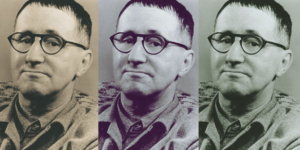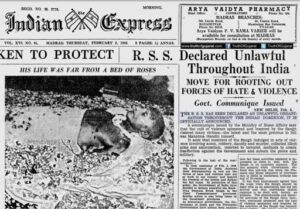Another January 30 has come and gone but it is worth underlining why we should remember Gandhi, even ritually, on the anniversary of his assassination.
The answers he gave to questions that confronted India from the second decade of the 20th century were shaped by the historical specificities of his age, that of colonialism. But then, all answers that philosophers give to dilemmas of the human condition are historically specific.
What remain eternal are the questions themselves.
India continues to confront the questions Gandhi tried to negotiate on the nature of freedom, systems of public ethics, the legitimacy of collective action, and, above all, how the threat of both state and social violence can be countered. We have to turn to Gandhi before we even attempt to address these questions. We need not replicate the past, but we need to learn from the history of ideas.
We live in troubled times; in times of great violence. We have to reinvent Gandhi not as the Mahatma but as a political philosopher. That we cannot do unless we recollect that Gandhi was primarily a political man, not a metaphysician, not a philosopher of religion, and not even a saint.
His philosophy was shaped in and through sustained political engagement with concrete issues of the day. He did not retreat to the metaphorical cave to reflect on these problems; he went into the street to evaluate what the need of the hour was. He believed that truth cannot be comprehended in and through processes of solitary reflection or meditation, it can only be found in the plurality and the unity of life.
“If I could persuade myself that I should find Him [God] in a Himalayan cave”, writes Gandhi, “I would proceed there immediately. But I know I cannot find Him apart from humanity”.
God for him, we need to recollect, was truth, or in more commonplace terms, knowledge.
Consider the political context in which he wrote Hind Swaraj in 1909 and we will find an answer to why he wrote this little text, which is now seen as a classic. After the suppression of the 1857 revolt, the colonial state embarked on ruthless policies of punishment and reprisal. The government clearly intended to humiliate an entire people, to hammer them into submission, and to strip them of any vestige of self-respect.
It is not surprising that young people came to believe that they could wipe out dishonour and regain a sense of who they were, only if they were to pick up the ‘gun’ and train the barrel at the colonial government. Violence begets violence. In the aftermath of the 1905 partition of Bengal and rampant discontent, violence became the common currency of resistance politics. A number of groups, dedicated to the cult of violence, came together across the country and abroad, particularly in London.
At a meeting of the Indian National Association held at the Imperial Institute in London on the first of July 1909, a murder was committed. The assassin was a young Indian student, Madan Lal Dhingra, and the victim was the political Aide-de-camp to the Secretary of State for India John Morley, Sir William H. Curzon-Wyllie.
Hailing from a propertied and an influential Hindu family living in Amritsar, Madan Lal Dhingra travelled to England for further studies in 1906. He completed a course in engineering and was headed back to India in October 1909. But a number of events intervened to frustrate his plan. He became a part of India House, which had become a centre of radical politics. A number of future leaders of the freedom struggle were part of the radical circle: Lajpat Rai, the future leader of the Ghadar movement Har Dayal and the Communist leader Virendranath Chattopadhyaya among others.
On May 10, 1909, the annual celebration of honouring the martyrs of the 1857 revolt against British colonialism was held. Several emotion-laden speeches, and charged denunciations of colonial brutality stimulated a young Indian student to take a life. On July 27, Dhingra was tried for murder and sentenced to death. He was hanged at Pentonville Prison on August 17 of the same year.
News of the assassination had reached Gandhi who was travelling from South Africa to London by ship. Gandhi was acquainted with Curzon Wylie, but his dismayed reaction to news of the murder outstripped personal grief. Violence, he had come to believe by 1909, was not only utterly futile, it was corrupt, corrupting, and sterile.
Nothing good came out of violence but violence, nothing ever could. This conviction had shaped his choice of political strategies-satyagraha-against the racist regime in South Africa. The only way to counter violence was self-suffering and not the infliction of suffering on others.
Whenever in London, Gandhi connected with Indian groups who spoke of the need for political violence. At a meeting to honour Dhingra, the chief spokesperson of the India House radicals in London, Vinayak Damodar Savarkar, read aloud the letter written by Dhingra: “[T]he only lesson required for India at present is to learn how to die, and the only way to teach it is by dying ourselves. Therefore I die, glorying in my martyrdom.”
Gandhi despaired. This despair motivated him to intellectually address and thereby repudiate political violence in Hind Swaraj and in later letters and speeches.
He penciled Hind Swaraj on board the ship Kildonan Castle on his way back to South Africa. The text, as he remarked later, was an answer to the Indian school of violence, and its prototype in South Africa.
“I came in contact with every known Indian anarchist in London. Their bravery impressed me, but I feel that their zeal was misguided. I felt that violence was no remedy for India’s ills, and that her civilization required the use of a different and higher weapon for self-protection.”
Gandhi begins his critique of violence in Hind Swaraj by unsparingly condemning the culture of violence embraced by ‘misguided patriots’. This was in response to the ‘reader’s’ suggestion that India could win independence by random acts of violence. A quarter of a million lives may be lost, but the land would be regained.
The partner to the dialogue, the ‘editor’ (who lip-syncs Gandhi’s words) responds with outrage: “[D]o you not tremble to think of freeing India by assassination?”
Gandhi’s central argument revolves around the impact of violence on the body politic. The violence of colonialism had precipitated violence as resistance, but the strategy is counter-productive. If the nationalist finger writes the alphabet of resistance in blood and gore, the script is ineffaceable. Violence leaves stigmata much like the murder of Duncan left blood on Lady Macbeth’s hands: ‘What, will these hands ne’er be clean?’
He recognised the enduring power of colonial violence. He also understood the attraction that violence holds for a people frustrated and exhausted by the depredations of colonialism. But he believed that it was possible to negate violence. If only we knew, Gandhi seemed to suggest, what violence is about, we would willingly forswear it.
He warns us that the power of violence over human beings must not be underrated. It is not a weapon that we can pick up and discard at will. It can best be likened to a quagmire that relentlessly sucks people into its murky depths. From here there is no escape. In other words, when violence holds individuals and groups in thrall, moral disintegration follows. For we cannot control violence; violence controls us.
Returning to Dhingra, Gandhi suggested that, “In my view Dhingra was innocent. The murder was committed in a state of intoxication. It is not merely wine or bhang that makes one drunk; a mad idea can do so. That was the case with Dhingra.”
When violence becomes the architect of history, Gandhi suggests, it can only replace one sort of oppression with another sort of oppression. Those who rise to power by murder, he said, will certainly not make the nation happy. “Those who believe that India has gained by Dhingra’s act and other similar acts in India make a serious mistake. Dhingra was a patriot, but his love was blind. He gave his body in a wrong way; its ultimate result can only be mischievous”.
If Independence is won through violence, people remain in the grip of violence, and those who have committed violent acts become the rulers. Nothing changes, and nothing ever could change when violence is used to craft the historical transition from colonialism to independence.
Moreover, though spectacular acts of political violence may appear courageous and praiseworthy, they belong to the realm of illusion. The masses might admire and acclaim revolutionaries for personal bravery, but they themselves remain untouched and steeped in passivity. Random violence is isolated from political mobilisation. It reduces people to an audience. No agent has invited them into history, and called upon them to make their own history. People are condemned to remain spectators of actions performed by others.
If the colonial state after the 1857 revolt had tried to browbeat Indians into submission through efforts to create compliant subjects, revolutionary violence had converted them into spectators. These enervating effects on popular energies had to be neutralised, and people brought to realisation that the attainment of freedom requires an enormous amount of hard work, courage, commitment to the truth, steadfastness, and above all a system of public ethics. It is only then that millions could be motivated to struggle against colonial domination. Swaraj or substantive freedom cannot be won by the actions of a few; it demands collective efforts and transformation.
Leaders must mobilise popular opinion by educating the people, motivating them, and transforming their beliefs. No person, once he or she has been radicalised, can ever be the same. And no society once it has been radicalised can ever be the same. Gandhi’s strategy of non-violent collective action rested on two beliefs.
One, sataygrahis had to prepare themselves through rigorous training and be prepared to face the consequences. That is, leaders of collective action had to legitimise themselves in the eyes of the political public before they entered the political arena.
Two, satyagrahis must mobilise public opinion by means of a wide and intensive agitation. The satyagrahi’s effort must necessarily depend not merely on the appeal to her/his own conscience but even more on the awakening of the slumbering conscience of a large number of people.
Distinguishing satyagraha from passive resistance and other forms of civil disobedience, Gandhi suggested that the philosophy is not a weapon of the weak. It demands tremendous moral strength and fortitude because it commands that we relentlessly battle with injustice with steadfastness, commitment, fearlessness, and willingness to accept punishment. The doctrine is superior to that of violence because it accepts suffering rather than inflict suffering on others.
The philosophy of satyagraha enlightens the mind, but more importantly gives to us a theory of collective action. The satyagrahi enables people to distinguish between what is right and what is wrong, encourages awareness of injustice and emphasises the need to fight for justice and against abuse of state power. In the process, people make the transition from an audience to an agent.
That is why satyagraha is preferable to revolutionary violence.
There is much more to Gandhi’s philosophy of non-violence and satyagraha. What is significant is his contribution to understanding that all states are inherently coercive; all states are embodiments of violence. State sponsored violence has to be fought. Resistance to state power is legitimate provided that the strategy of the resistors does not mirror the violence of the state. The use of violence to achieve political objectives is simply bad politics.
Violence stamps the body politic with its cloven hoof, it reduces isolated acts of resistance to spectacle, it diminishes the political public to an audience, and it systematically erodes public ethics. If states cannot uphold a system of public ethics, the people must do so. They must take up the task of defending public ethics. In the process, we might conquer our own fatal tendency to inflict violence on each other.
(Neera Chandhoke is former professor of political science, Delhi University. Article courtesy: The Wire.)




